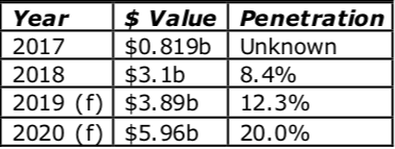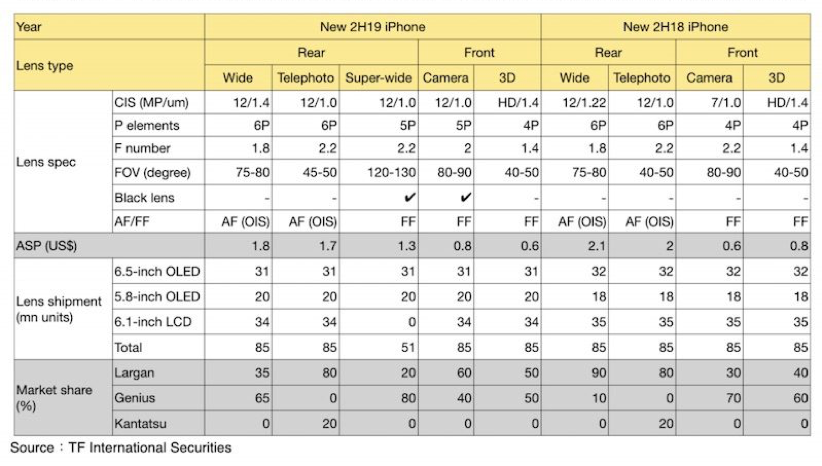Vertical Divider
|
Update on Sony’s TOF Camera Technology
April 29, 2019 Last month, we reported on Time of Flight (TOF) cameras that had been showing up on smartphones. These systems, which were originally expected to be an alternative to structured light systems, such as those used in the iPhone, have found a 2nd purpose as longer-range depth information sources used for image modification or AR on mobile devices. Out of 81 model announced or released between the beginning of the year and mid-March 6 or 7.4% had TOF sensors. Since then two TOF smartphones have been added, the Samsung A80 and the Huawei P30 Pro. In keeping with Samsung’s goal of moving new technology across all smartphone lines, rather than adding only to high-end products, Samsung pushed the new technology onto a mid-tier phone first, as opposed to the high-end Galaxy S10 5G model. Similarly, Huawei first introduced TOF this year in their Mate X foldable smartphone, which will sell for ~$2,100, while their newest TOF entry, the P30 Pro, while it is still a high-end model, sells for just under $1,000. More importantly will be Huawei’s next release, which would indicate whether they are following a path similar to Samsung. Xiaomi could release their first model containing TOF this year, which will likely be the Mi Max 4 at an appreciably lower price point. The Mi Max 4 to sell around $350 to $400). |
|
Penetration of the 3D sensor market including structured light systems such as those used in the iPhone, due primarily to structured light systems that are ‘copycats’ of Apple’s system, but should Apple adopts TOF, either as a replacement for, or in addition to (more likely) structured light sensing, TOF will become a significant contributor to the 3D sensor market. Apple is expected to adopt TOF in 2020 as a way to generate 3D data for AR applications, which will appear in the iPhone next year.
Table 1: 3D Sensing Market Metrics
Table 1: 3D Sensing Market Metrics
Source: Trendforce
All three 2019 iPhones will feature 12-megapixel single-lens front cameras, up from 7-megapixels on the iPhone XS, iPhone XS Max, and iPhone XR, according to the latest research note Ming-Chi Kuo.
Figure 1: 2019 iPhone
Figure 1: 2019 iPhone
Source: Ming-Chi Kuo
MacRumors reported that the next iPhone XS and iPhone XS Max models with 5.8-inch and 6.5-inch OLED displays respectively will also feature triple-lens rear cameras, including a 12-megapixel telephoto lens, 12-megapixel wide-angle lens, and a 12-megapixel super-wide-angle lens supplied by Sony:
The camera upgrade is expected to be one of the 2019 iPhone's major selling points. Critical spec upgrades include:
Table 2: iPhone Camera Lens Specs
The camera upgrade is expected to be one of the 2019 iPhone's major selling points. Critical spec upgrades include:
- Rear cameras of 6.5-inch OLED, 5.8-inch OLED, and 6.1-inch LCD will likely upgrade to triple-camera and dual-camera, respectively. A super-wide camera will be newly adopted by the triple-camera system, which is equipped with the 12MP/1um CIS provided exclusively by Sony.
- The front camera of all three new iPhone models will likely upgrade to 12MP CIS+5P lens (vs. current 7MP CIS+4P lens).
- Thenext iPhone XR with a 6.1-inch LCD display will sport a dual-lens rear camera, although Kuo did not provide megapixels or any other camera specifications for that model. The rear camera on the current iPhone XR is a single 12-megapixel wide-angle lens.
- The rear super-wide-angle lens and front camera lens on the next iPhone XS and iPhone XSMax will adopt "black lens-coating technologies," which will make the lenses look "inconspicuous".
- The triple lens camera design for the next iPhones has proved quite controversial, but the special coating should help the far-right lens blend into the black bezels for a more aesthetically pleasing look.
Table 2: iPhone Camera Lens Specs
Source: TF International Securities
Speaking of cameras, Samsung has some of the most advanced camera optics, but still lag behind competitors in the software department. Samsung was the first to introduce the concept of variable aperture on smartphones but most its leading models lack a dedicated night mode – which is currently limited to the Galaxy S10 series. The Google Pixel by comparison has raised the bar of smartphone photography with just a single lens, thanks to Google’s expertise in computational photography. Samsung’s brilliant camera hardware paired with the unofficial Google Camera mode can produce some crisp and detailed images as well as visibly uplift the amount of exposure in low light conditions. With the latest update, the Google Camera mod is adding the ability to switch the aperture between f/2.4 and f/1.5 on Samsung Galaxy flagships. The new feature will apply to all Galaxy S and Note series devices with dual aperture, including the Galaxy S9/S9+, the Galaxy Note 9, and the Galaxy S10 lineup. Toggling for shifting to a wider aperture manually should improve the performance of Night Sight on the Samsung Galaxy smartphones.
The new update also brings new options in Settings, including a toggle to hide or unhide advanced settings. The new Google Camera mod, based on Google Camera ver. 6.2, now works even without GApps installed. Further, Top Shot now works with Google Photos even on non-Pixel devices. Additionally, the update should also support the new Selfie Flash, which changes the background color of the camera UI from black to off-white while taking selfies in low-light, along with an option to mute the shutter sound, which may be restricted to certain locations only.
If you’re using a Galaxy S9/S9+, Galaxy Note 9, or one of the Galaxy S10 devices, you can go ahead and download the Google Camera mod ver. 6.2 and install it without needing to modify or root your Samsung Galaxy device. You can also consider donating to Senior member S4turno who runs a dedicated server to host these files.
The new update also brings new options in Settings, including a toggle to hide or unhide advanced settings. The new Google Camera mod, based on Google Camera ver. 6.2, now works even without GApps installed. Further, Top Shot now works with Google Photos even on non-Pixel devices. Additionally, the update should also support the new Selfie Flash, which changes the background color of the camera UI from black to off-white while taking selfies in low-light, along with an option to mute the shutter sound, which may be restricted to certain locations only.
If you’re using a Galaxy S9/S9+, Galaxy Note 9, or one of the Galaxy S10 devices, you can go ahead and download the Google Camera mod ver. 6.2 and install it without needing to modify or root your Samsung Galaxy device. You can also consider donating to Senior member S4turno who runs a dedicated server to host these files.
|
Contact Us
|
Barry Young
|



